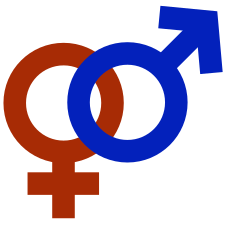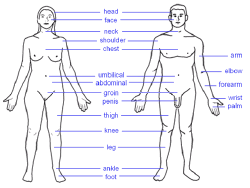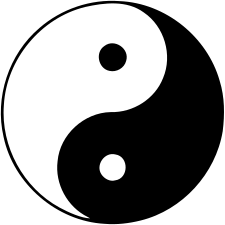Gender
Gender traditionally refers to the differences between men and women. More recently, it has also referred to an individual's self perception of being male or female. Within the academic fields of cultural studies, gender studies, and the social sciences "gender" is used interchangeably both regarding "sex," and "identity," and is often used to described a gender role.
Gender roles traditionally were often divided into distinct feminine and masculine roles until the late twentieth century, when many jobs in both industrial and information-age societies could be performed by both males and females. In many modern societies gender no longer determines the work or household functions that an individual can perform, allowing greater equality for all people to compete in the workplace and earn a livable wage.
In recent years, many societies have recognized same sex marriages in which partners may or may not identify with specific gender roles. This can be important for legal purposes related to health benefits and estate inheritance for committed partnerships. However, biologically, it is only biological females who are capable of bearing children. Thus there is continued confusion about sex and gender roles related to marriage and sexual love in the structure of families. Rather than describing a loving partnership between individuals as marriage, marriage as a social institution was traditionally related to raising children and establishing stable, peaceful, and happy societies. This can be confusing as it is often unclear whether laws concerning marriage are for the purpose of human partnerships or child-raising social institutions.
Etymology and usage
The word gender comes from the Middle English gendre, a loanword from Norman-conquest-era Middle French. This, in turn, came from Latin genus. Both words mean "kind," "type," or "sort." They derive ultimately from a widely attested Proto-Indo-European (PIE) root gen-.[1]
In English, both "sex" and "gender" are used in contexts where they cannot be substituted—"sexual intercourse," "safe sex," "sex worker," or on the other hand, "grammatical gender." Other languages, like German or Dutch, use the same word, Geschlecht or Geslacht, to refer not only to biological sex, but social differences and grammatical gender as well, making a distinction between 'sex' and 'gender' difficult. In some contexts, German has adopted the English loanword Gender to achieve this distinction. Sometimes Geschlechtsidentität is used for "gender" (although it literally means "gender identity") and Geschlecht for "sex."
Biological concept of gender
Gender can refer to the biological condition of being male or female, or less commonly intersex or "third sex" as applied to humans, or hermaphroditic, as applied to non-human animals and plants.
The biology of gender is scientific analysis of the physical basis for behavioral differences between men and women. It is more specific than sexual dimorphism, which covers physical and behavioral differences between males and females of any sexually reproducing species, or sexual differentiation, where physical and behavioral differences between men and women are described.
Biological research of gender has explored such areas as: Intersex physicalities, gender identity, gender roles, and sexual preference. Late twentieth century study focused on hormonal aspects of the biology of gender. With the successful mapping of the human genome, early twenty-first century research started making progress in understanding the effects of gene regulation on the human brain.
It has long been known that there are correlations between the biological sex of animals and their behavior.[2] It has also long been known that human behavior is influenced by the brain.
The late twentieth century saw an explosion in technology capable of aiding gender research. Extensive advances were made in understanding sexual dimorphism in animals, such as the effects of sex hormones on rats. The early twenty-first century producing results concerning genetically programmed sexual dimorphism in rat brains, prior even to the influence of hormones on development. "Genes on the sex chromosomes can directly influence sexual dimorphism in cognition and behavior, independent of the action of sex steroids."[3]
Differences between genders
The brains of many animals, including humans, are significantly different for males and females of the species.[4] Both genes and hormones affect the formation of many animal brains before "birth" (or hatching), and also behavior of adult individuals. Hormones significantly affect human brain formation, and also brain development at puberty. Both kinds of brain difference affect male and female behavior.
Although men have a larger brain size, even when adjusted for body mass, there is no definite indication that men are more intelligent than women. In contrast, women have a higher density of neurons in certain parts of the brain. Difference is seen in the ability to perform certain tasks. On average, women are superior on various measures of verbal ability, while men have specific abilities on measures of mathematical and spatial ability.
Richard J. Haier and colleagues at the universities of New Mexico and California (Irvine) found, using brain mapping, that men have more than six times the amount of gray matter related to general intelligence than women, and women have nearly ten times the amount of white matter related to intelligence than men.[5] "These findings suggest that human evolution has created two different types of brains designed for equally intelligent behavior," according to Haier. Gray matter is used for information processing, while white matter consists of the connections between processing centers.
It has also been demonstrated that brain processing responds to the external environment. Learning, both of ideas and behaviors, appears to be coded in brain processes. It also appears that in several simplified cases this coding operates differently, but in some ways equivalently, in the brains of men and women. "Even when men and women do the same chores equally well, they may use different brain circuits to get the same result."[6] For example, both men and women learn and use language; however, bio-chemically, they appear to process it differently. Differences in male and female use of language are likely reflections both of biological preferences and aptitudes and of learned patterns.
Biological influences on gender are present in the act of sexual intercourse itself, along with the resulting pregnancy in which women must carry the unborn child for nine months. Following the birth of the child, mothers also have the physical connection of breast-feeding. These are seen as the roots of one difference in attitudes and actions by gender. These roots grow to take the form of different child rearing roles and can be seen as an influence on the concept of gender overall.
Social concepts of gender
Since the 1950s, the term "gender" has been increasingly used to distinguish a social role (gender role) and/or personal identity (gender identity) distinct from biological sex. Sexologist John Money wrote in 1955, "[t]he term gender role is used to signify all those things that a person says or does to disclose himself or herself as having the status of boy or man, girl or woman, respectively. It includes, but is not restricted to, sexuality in the sense of eroticism."[7] Elements of such a role include clothing, speech patterns, movement and other factors not solely limited to biological sex.
Many societies categorize all individuals as either male or female—however, this is not universal. Some societies recognize a third gender;[8] for instance, the Two-Spirit people of some indigenous American peoples, and hijras of India and Pakistan;[9] or even a fourth[10] or fifth.[11] Such categories may be an intermediate state between male and female, a state of sexlessness, or a distinct gender not dependent on male and female gender roles. In some cultures, such gender identities are referred to as "non-binary." Joan Roughgarden argued that in some non-human animal species, there can also be said to be more than two genders, in that there might be multiple templates for behavior available to individual organisms with a given biological sex.[12]
Some gender associations are changing as society changes, yet much controversy exists over the extent to which gender roles are simply stereotypes, arbitrary social constructions, or natural innate differences.
There has been significant debate over to what extent gender is a social construct and to what extent it is a biological construct. One point of view in the debate is social constructionism, which suggests that gender is entirely a social construct. Contrary to social constructionism is essentialism, which suggests that it is entirely a biological construct. Other opinions on the subject lie somewhere in between.
Feminism and gender
Feminists take different views on gender, mainly in three camps. The first camp embraces gender roles, focusing on the biological differences between sexes and emphasizing the roles that result. This school takes the view that women are natural child caretakers as a result of their biological function of childbirth and breast-feeding. The second camp acknowledges that the sexes may have different natural strengths, but fights for equal treatment of both genders rather than only valuing the strengths traditionally found in males. The third camp of feminists argues that the concept of gender should be abolished as no one lives up to the prototype of either sex, therefore gender norms create unhealthy ideal genders impossible to meet by anyone.
Gender in law
Gender has had a diverse impact in law. Beginning from the birth of a child, one can look at the leave of absence offered to parents of new-born children. Traditionally women have been offered a much longer maternity leave than the father of the child is allowed to take as paternity leave. Similarly, if these parents were to be divorced, many legal systems have given priority for custody to the mothers. Also, divorced mothers have tended to receive more benefits in child support than divorced fathers.
From the point of view of the child, the education received by children has been divided into all girls or all boys schools in many cultures. Participation in sports has long been subject to gender bias. In this arena, males have a long history of being favored. It was not until the 1970s, when actions such as Title IX of the U.S. "Education Amendment" came about mandating equal funding for women's sports, that women had equal opportunity to engage in sports.
For adults, there are many legal implications of one's gender. A person's sex as female or male has legal significance throughout one's life—sex is indicated on government documents, and laws provide differently for women and men. For example, the prison to which criminals are sent, or the housing within any government run institution, varies by their perceived gender; many pension systems have different retirement ages for men and women, and usually marriage is only available to opposite-gender couples.
The question then arises as to what legally determines whether someone is male or female. In most cases, this can appear obvious, but the matter is complicated for intersexual or transgender people. Different jurisdictions have adopted different answers to this question. Almost all countries permit changes of legal gender status in cases of intersexualism, when the gender assignment made at birth is determined upon further investigation to be biologically inaccurate—technically, however, this is not a change of status per se. Rather, it is recognition of a status which was deemed to exist unknown from birth. Increasingly, jurisdictions also provide a procedure for changes of legal gender for transgender people.
Gender assignment, when there are any indications that genital sex might not be decisive in a particular case, is normally not defined by any single definition, but by a combination of conditions, including chromosomes and gonads. Thus, for example, in many jurisdictions a person with XY chromosomes but female gonads could be recognized as female at birth.
The ability to change legal gender for transgender people in particular has given rise to the phenomena in some jurisdictions of the same person having different genders for the purposes of different areas of the law. For example, in Australia prior to the Re Kevin decisions, a transsexual person could be recognized as the gender they identified with under many areas of the law, such as social security law, but not for the law of marriage. Thus, for a period it was possible for the same person to have two different genders under Australian law. It is also possible in federal systems for the same person to have one gender under state law and a different gender under federal law (if the state recognizes gender transitions, but the federal government does not).
Gender in religion
In Taoism, yin and yang are considered feminine and masculine, respectively.
In Christianity, God is described in masculine terms; however, the Church has historically been described in feminine terms.
Of one of the several forms of the Hindu God, Shiva, is Ardhanarishwar (literally half-female God). Here Shiva manifests himself so that the left half is Female and the right half is Male. The left represents Shakti (energy, power) in the form of Goddess Parvati (otherwise his consort) and the right half Shiva. Whereas Parvati is the cause of arousal of Kama (desires), Shiva is the killer. Shiva is pervaded by the power of Parvati and Parvati is pervaded by the power of Shiva.
While the stone images may seem to represent a half-male and half-female God, the true symbolic representation is of a being the whole of which is Shiva and the whole of which is Shakti at the same time. It is a 3-D representation of only shakti from one angle and only Shiva from the other. Shiva and Shakti are hence the same being representing a collective of Jnana (knowledge) and Kriya (activity).
Adi Shankaracharya, the founder of non-dualistic philosophy (Advaita–"not two") in Hindu thought says in his "Saundaryalahari"—Shivah Shaktayaa yukto yadi bhavati shaktah prabhavitum na che devum devona khalu kushalah spanditam api It is only when Shiva is united with Shakti that He acquires the capability of becoming the Lord of the Universe. In the absence of Shakti, He is not even able to stir. In fact, the term "Shiva" originated from "Shva," which implies a dead body. It is only through his inherent shakti that Shiva realizes his true nature.
This mythology projects the inherent view in ancient Hinduism, that each human carries within himself both male and female components, which are forces rather than sexes, and it is the harmony between the creative and the annihilative, the strong and the soft, the proactive and the passive, that makes a true person. Such thought obliterates any material distinction between the male and female altogether. This may explain why in ancient India evidence is found of homosexuality, bisexuality, androgyny, multiple sex partners, and open representation of sexual pleasures in artworks like the Khajuraho temples, being accepted within prevalent social frameworks.[13]
Gender in other contexts
The word "gender" is used in several contexts to describe binary differences, more or less loosely associated by analogy with various actual or perceived differences between men and women.
Language
Natural languages often make gender distinctions. These may be of various kinds:
- Grammatical gender, a property of some languages in which every noun is assigned a gender, often with no direct relation to its meaning. For example, Spanish muchacha (grammatically feminine), German Mädchen (grammatically neuter), and Irish cailín (grammatically masculine) all mean "girl." The terms "masculine" and "feminine" are generally preferred to "male" and "female" in reference to grammatical gender.
- The traditional use of different vocabulary by men and women. For instance, there are differences in spoken Japanese depending on whether the speaker is male or female.
- The asymmetrical use of terms that refer to males and females. Concern that current language may be biased in favor of males has led some authors in recent times to argue for the use of more Gender-neutral language in English and other languages.
Connectors and fasteners
In electrical and mechanical trades and manufacturing, and in electronics, each of a pair of mating connectors or fasteners (such as nuts and bolts) is conventionally assigned the designation "male" or "female." The assignment is by direct analogy with animal genitalia; the part bearing one or more protrusions, or which fits inside the other, being designated male and the part containing the corresponding indentations or fitting outside the other being female.
Music
In western music theory, keys, chords, and scales are often described as having "major" or "minor" tonality, sometimes related to "masculine" and "feminine." By analogy, the "major" scales are masculine (clear, open, extroverted), while the minor scales are given feminine qualities (dark, soft, introverted). Reflecting this connection to gender, German uses the word Tongeschlecht ("Tone gender") for tonality, and the words Dur (from Latin durus, hard) for major and moll (from Latin mollis, soft) for minor.
Notes
- ↑ Douglas Harper, gender Online Etymology Dictionary. Retrieved December 22, 2020.
- ↑ Charles Darwin, On the Origin of Species by Means of Natural Selection, or the Preservation of Favoured Races in the Struggle for Life (London: John Murray, 1859).
- ↑ David H. Skuse, Sexual dimorphism in cognition and behavior: the role of X-linked genes, European Journal of Endocrinology (155): 99-106.
- ↑ Robert W. Goy and Bruce S. McEwen, Sexual Differentiation of the Brain: Based on a Work Session of the Neurosciences Research Program. Retrieved December 22, 2020.
- ↑ Richard J. Haier, Rex E. Jung, Ronald A. Yeo, Kevin Head, and Michael T. Alkire, Structural Brain Variation and General Intelligence, NeuroImage 23 (2004): 425–433. Retrieved December 22, 2020.
- ↑ Linda Marsha, He Thinks, She Thinks, Discover, July 5, 2007. Retrieved December 22, 2020.
- ↑ J. Money, "Hermaphroditism, gender and precocity in hyperadrenocorticism: Psychologic findings," Bulletin of the Johns Hopkins Hospital 96: 253–264.
- ↑ Gilbert Herdt (ed.), Third Sex Third Gender: Beyond Sexual Dimorphism in Culture and History (Zone Books, 1996, ISBN 0942299825).
- ↑ Serena Nanda, Neither Man Nor Woman: The Hijras of India (Wadsworth Publishing, 1998, ISBN 0534509037).
- ↑ Will Roscoe, Changing Ones: Third and Fourth Genders in Native North America (Palgrave Macmillan, 2000, ISBN 0312224796).
- ↑ Sharyn Graham, Sulawesi's fifth gender Inside Indonesia, July 30, 2007.
- ↑ Joan Roughgarden, Evolution's Rainbow: Diversity, Gender, and Sexuality in Nature and People (University of California Press, 2004, ISBN 0520240731).
- ↑ Ashok Vohra, "The Male-Female Hologram," Times of India, March 8, 2005, Page 9.
ReferencesISBN links support NWE through referral fees
- Baron-Cohen, Simon. The Essential Difference: The Truth about the Male and Female Brain. Basic Books, 2003. ISBN 046500556X.
- Brizendine, Louann. The Female Brain. New York: Morgan Road Books, 2006. ISBN 0767920100.
- Brown, Donald E. Human Universals. Temple University Press, 1991. ISBN 0877228418.
- Chafetz, J. S. Masculine/feminine or human? An Overview of the Sociology of Sex Roles. Itasca, IL: F. E. Peacock, 1978. ISBN 0875812317.
- Darwin, Charles. On the Origin of Species by Means of Natural Selection, or the Preservation of Favoured Races in the Struggle for Life. London: John Murray, 1859.
- Herdt, Gilbert (ed.). Third Sex Third Gender: Beyond Sexual Dimorphism in Culture and History. Zone Books, 1996. ISBN 0942299825.
- Kimura, Doreen. Sex and Cognition. MIT Press, 2000. ISBN 0262611640.
- Moir, Anne, and David Jessel. Brain Sex: The Real Difference Between Men and Women. Delta, 1992. ISBN 0385311834.
- Nanda, Serena. Neither Man Nor Woman: The Hijras of India. Wadsworth Publishing, 1998. ISBN 0534509037.
- Pinker, Steven. The Blank Slate: A Modern Denial of Human Nature. London: Penguin Books, 2002. ISBN 0142003344.
- Reddy, Gayatri. With Respect to Sex: Negotiating Hijra Identity in South India. University Of Chicago Press, 2005. ISBN 0226707563.
- Roscoe, Will. Changing Ones: Third and Fourth Genders in Native North America. Palgrave Macmillan, 2000. ISBN 0312224796.
- Roughgarden, Joan. Evolution's Rainbow: Diversity, Gender, and Sexuality in Nature and People. University of California Press, 2004. ISBN 0520240735.
External links
All links retrieved April 18, 2024.
- Kritz, Francesca Lunzer. 'Not Feeling Each Other's Pain: Men and Women Hurt Differently—and Some of The Difference May Really Be in Their Heads'. The Washington Post, December 19, 2006. Page HE01.
- Pinker vs. Spelke. 'The Science of Gender and Science'. Edge (The Third Culture) May 16, 2005. (multimedia record of public debate)
- Children’s Gender Beliefs: A Review of Past Research Exploring A Variety of Variables
- Gender and health WHO
- Sex and gender: What is the difference? Medical News Today
- What’s the Difference Between Sex and Gender? Healthline
Credits
New World Encyclopedia writers and editors rewrote and completed the Wikipedia article in accordance with New World Encyclopedia standards. This article abides by terms of the Creative Commons CC-by-sa 3.0 License (CC-by-sa), which may be used and disseminated with proper attribution. Credit is due under the terms of this license that can reference both the New World Encyclopedia contributors and the selfless volunteer contributors of the Wikimedia Foundation. To cite this article click here for a list of acceptable citing formats.The history of earlier contributions by wikipedians is accessible to researchers here:
The history of this article since it was imported to New World Encyclopedia:
Note: Some restrictions may apply to use of individual images which are separately licensed.








